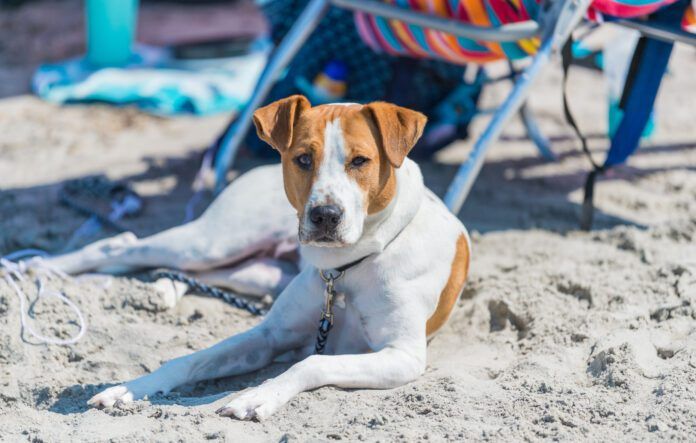Whole Dog Journal is reader-supported. If you purchase through links on our site we may earn a commission. Whole Dog Journal does not accept money for its food and product reviews.
Most dogs are covered from head to tail with a natural sunburn deterrent called fur. But despite this natural protective covering, dogs can still get sunburn on certain areas of their bodies.
Areas where their fur is thinnest or non-existent are particularly prone to developing sunburn. This includes the ears, nose, and the underside of the belly. And it’s not just dogs who like to lay on their backs in the sun that need protection on their bellies. The sun’s rays can be reflected up onto a dog’s belly from white sidewalks, beach sand, water, and snow, making this region vulnerable to sunburn during walks or water sports.
Naturally hairless breeds, like the Chinese Crested or Xoloitzcuintli, need sun protection for obvious reasons. But dogs with white, yellow, light gray, or tan haircoats typically have fair skin underneath, making them more susceptible to sunburn. Dogs with a thin haircoat or that have a condition causing patchy hair loss need protection from the sun’s harmful rays. Dogs who have been shaved, either as part of a grooming routine or because of a recent surgery, will need to be protected against sunburn.
There are a few ways that you can protect your best friend’s skin from the sun. These methods include using sunscreen made for dogs, dressing him in sun-protective clothing, and avoiding outdoor activities during the time of day when the sun’s rays are the most intense.
Sunscreen for dogs
There are several sunscreen products made specifically for dogs. Look for a product that has an SPF (sun protection factor) rating of at least 30 SPF and that provides protection against both UVA and UVB rays. Forms of dog sunscreens include both sprays and lotions.
Sunscreen sprays can be used on your dog’s body. Avoid using sunscreen sprays on or near your dog’s face as your dog could accidentally inhale the sunscreen during application. Use sunscreen lotion on sun-sensitive areas of your dog’s face, such as the nose and ears.
Sunscreen should be applied at least 15 minutes prior to going outside. Do not let your dog lick the sunscreen that has been applied to his skin. Reapply sunscreen every few hours and more often if he gets wet. Do not use sunscreen made for humans as these products may contain zinc oxide, PABA, or salicylates.
Sun-protective clothing for dogs

Sun-protective clothing may be a good option for hairless breeds and dogs with thin hair coats or patchy areas of hair loss. There are a variety of clothing options available, including sun suits that provide excellent coverage of the body, neck, and limbs. Other options include t-shirts, neck gaiters, and hats.
Look for clothing that has a UPF (ultraviolet protection factor) of 30 or greater. Most sun-protective clothing has a rating of 15, 30, or 50 UPF. A rating of 50 UPF means that the apparel is capable of keeping 98% of harmful UVA and UVB rays from reaching your dog’s skin.
Wearing sun-protective clothing may impair your dog’s ability to keep cool. You may want to avoid using sun-protective clothing if the outside temperature is greater than 70 degrees Fahrenheit (21 degrees Celsius). During the summer months, avoid using sun-protective clothing if the dew point is greater than 65 degrees Fahrenheit (18 degrees Celsius).
If your dog is panting or moving slower than usual while wearing sun protective clothing, remove the clothing and move him to a shady area. See “Heat Stroke in Dogs” for more information about how to help a dog exhibiting signs of heat stroke.
Avoiding your dog’s sun exposure
The sun’s ultraviolet rays are at their greatest intensity between the hours of 10am and 4pm. Dogs who are the most vulnerable to sunburn should avoid outdoor activity during these hours.
Sunburned skin does not become painful until after the damage has been done. Dogs who are laying outside in the sunshine may not move to a shady spot unless they become too warm. Skin can become sunburned in as little as 10 minutes on a high UV-index day.
How to treat sunburn in dogs
If your dog develops a sunburn, do not despair! Skin that is pink and not painful can be treated at home by bathing with a soothing oatmeal shampoo. After the soothing oatmeal bath, you can apply a layer of aloe vera gel or spray that is made specifically for dogs, such as Frisco’s Aloe Hydrating Spray.
Skin that is red and painful or that has developed blisters and flaking are indicators of more severe sunburn and should be assessed by a veterinarian. It can take 24 to 72 hours for sunburned skin to declare its true severity, so closely monitor your dog to ensure that his sunburn is improving and not becoming worse.
Bright sunlight does not need to be a deterrent to being outdoors. Utilize sun protection for both you and your dog and enjoy your outdoor activities!






